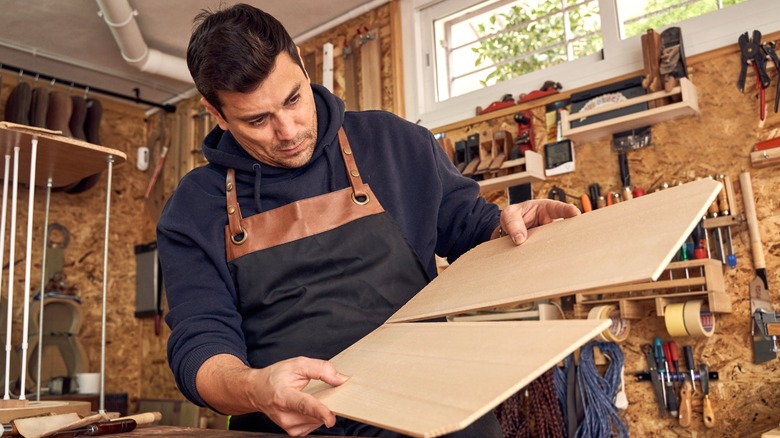A Cool Trick To Joint Wood Boards With Nothing But A Table Saw
We may receive a commission on purchases made from links.
You can't overlook the value of quality edge jointing during furniture builds and other woodworking projects. Removing gaps and imperfections is critical for instilling a cohesive elegance in the final product, allowing the best possible look and function. However, convenient ways to get a perfect alignment between two boards can be few for the average hobbyist. Running them through a jointer? Not everyone has the space, money, or need for that equipment. How about hand-planing? That can take a fair amount of time, patience, and trial and error. While it can seem like labor-intensive routes are the only option, you'll be glad to know you can create a seamless joint in seconds with a tool worth investing in to start woodworking at home — a table saw.
It's easy to overcomplicate our thinking when trying to solve woodworking problems, but as Instagram user @parkplaceabode demonstrated, the best solutions often reveal themselves when we take the simplest approach. With this technique, you connect two boards at the edge you want to joint and run the table saw blade down the seam. With the blade creating a matching cut on both sides, the inconsistencies disappear, and the pieces achieve matching edges. Since both boards lie flat on the table saw surface, this also ensures the connection is always square, eliminating any uneven tilt from one piece to the next. With this clever hack, you'll take your next build from rough-and-ready to refined, all in a single rip!
How to get a seamless fit without a jointer
To joint two boards using your table saw, you'll create spanners that hold the boards in place as you pass the seam through the saw. Always take the necessary woodworking safety precautions, and make sure to use a push stick when jointing narrow boards to protect your hands. Position the boards in the orientation you need for your project. Note any gaps wider than the saw blade kerf. If you find any, you'll have to rip the boards individually, trimming and straightening the joint edges enough to narrow the gaps. Then, get several pieces of scrap wood and line one side of each piece with double-sided woodworking tape, like XFasten Double-Sided Woodworking Tape. With the boards lined up where you want to connect them, place each wood piece over the seam. Lay them tape side down to hold the boards together, spacing them evenly from end to end.
Set the table saw blade height just high enough to cut through the boards. It's okay to cut into the spanners a little, just not so much that it might weaken their grip on the boards. You can use a genius wood-cutting hack to create a DIY clamp to secure the boards at the cut end as you pass them through the saw. The end clamp can be particularly helpful in keeping thinner or longer boards together through the cut. After cutting, line the boards up to check for gaps. You can sand and plane minor imperfections, but you're likely to find your boards will have the ideal tight fit.
